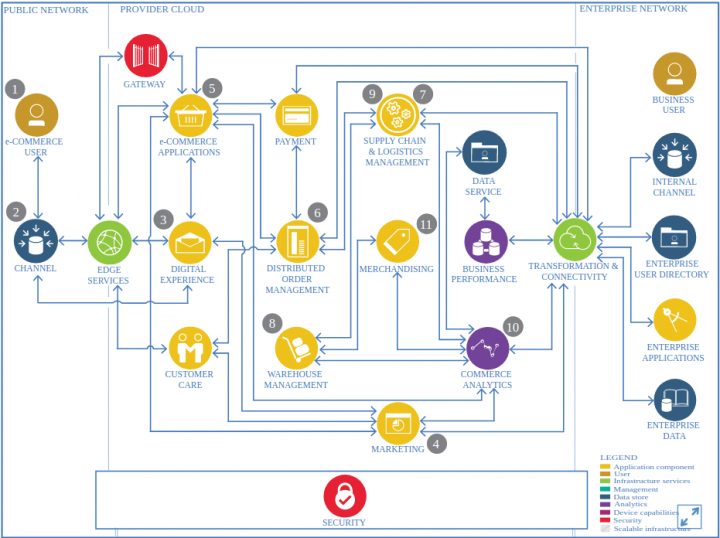So you need to build a skyscraper. The multipurpose high rise complex with some outrageous twists and turns in structure that will define the skyline of the city. Without an architect’s blueprint, engineers will just snicker at your idea.
The same thing works with a Magento solution architect. Whenever you need to build a website, especially a large-scale one with a complex ecommerce platform architecture, your ideas will run into a wall of engineers’ woes unless you hire a solutions architect. At best, developers will code your website into something that may be far from what you imagined.
At Elogic Commerce, all Adobe Commerce projects we have launched had a Magento-certified solution specialist on board. They are also an essential part of a team whenever our clients request ecommerce consulting sessions or an existing website revamp.
What does a Magento solution architect do and why you need one — read more in this article.
What Does a Magento Solution Architect do?
A famous software engineer and an advocate of Agile development methods, Robert C. Martin, said, “Good architecture makes the system easy to understand, easy to develop, easy to maintain, and easy to deploy. The ultimate goal is to minimize the lifetime cost of the system and to maximize programmer productivity.”
This is exactly what a Magento solutions specialist does. They describe and document a system at the component level, including the structure of the components, the way in which they interact, and the principles underlying their design and scalability.
Read also: How Much Ecommerce Website Costs: Set the Right Budget for Your Project
Other responsibilities of a Magento ecommerce solutions architect include:
- Coming up with simple solutions to complex technical problems
- Defining the project scope, estimating tasks, and providing support for developers
- Choosing the tech stack, third-party integrations, and other components required to meet the business goals
- Creating scalable, maintainable, flexible, and well-documented architectural solutions and designs for Magento sites
- Overseeing the development process to make sure the system design is implemented
- Engaging with clients to identify business requirements
- Supporting the Magento site through post-deployment and future iterations
Out of the five stages of a project’s life cycle (initiation, planning, execution, control, and closure), architects are active in three: planning, execution, and control.
While developing a Magento enterprise solution, an architect completes documentation, creates and assigns tasks, meets with developers and clients, and comes up with smart architectural solutions to make your site flexible, extensible, and usable in the long term.
Technical Architect, Solution Architect, or Solution Designer: One and the Same Thing?
Magento development teams might have three different roles depending on your project scope: Magento Solution Specialist, a Magento Solution Architect, and a certified Magento developer.
To gain a better understanding of the difference between these three roles, we asked Oksana Yakovlieva, Head of Project Management at Elogic, to explain it better.
“Building a custom website is like building a house,” she says. “You need an architect to plan the building, an interior designer to make the rooms look nice, and a team of developers to lay the bricks. A Magento Solution Architect is like an architect in a construction project, whereas a Solution Specialist performs the role of an interior designer. Magento developers — much like construction workers — build the project piece by piece.”
Let’s see the difference between Magento technical architect and solution architect, among others, in more detail.
Magento 2 Certified Solution Specialist (aka Solution Architect)
Solution architects are most similar to project managers. They assess your business, sales, and marketing requirements; transform them into deliverable digital solutions and features; and present strategic plans for their implementation.
This is the role you should fill in whenever you need to create a personalized tech product or fix technical issues.
Adobe Commerce has a respective certification for this role — AD0-E700 Adobe Certified Expert – Adobe Commerce Business Practitioner (ex Magento 2 certified solution specialist). They may not necessarily code but will efficiently align your business objectives with Magento 2 functionality, optimize use of native features, and avoid unnecessary customization.
Read more: Magento Certifications: List, Types & Tips to Get One
Being excellent project managers, Magento solution specialists will also oversee your software development process and deliver your project on time and on budget.
For instance, while working with Solotop, our Magento solution architect at Elogic suggested reusing the code of a similar project and following coding best practices to reduce the time of development by 2.5 times.

Technical Architect
A technical architect (aka system architect or software architect) is the one that defines and documents software structure and website behavior. The biggest difference between solution architect and software architect is that the former is a more client-facing role, while the latter focuses mostly on software engineering for a particular project.
A system architect decides on the high-level structure of your ecommerce website to ensure its performance, security, and scalability. So whenever you need to optimize your website speed, especially during Magento cloud architecture development, rest assured that you’ll find a software architect on your team.
For instance, for the Aussie fashion brand Whola, our technical architect at Elogic managed to decrease the page loading speed to <3 seconds and revamp the system architecture without tearing down the whole system.

Infrastructure Architect
Infrastructure architects are much like technical ones, except that they focus on the server environment. Whether your Magento website runs on on-premise servers or in the cloud, infrastructure architects reduce your chance of downtime and slow loading speed.
The main difference between cloud architect and solution architect is that the former ensures software is successfully deployed and operates well, while the latter designs a solution to address a specific business problem.
For example, while working on a project for a large industrial automation brand Wexon, our Magento architect at Elogic had to configure the company’s on-premise server environment and set firewalls to follow server productivity best practices.

Keep in mind: the difference between different Magento architect roles is subtle and may be fuzzy depending on who you talk to. Oftentimes, a single team member may perform all the aforementioned functions as long as he/she has respective certifications and sufficient expertise in Magento development.
How to Become a Magento Solution Architect
The road to becoming an accomplished architect is long and arduous. There’s a steep learning curve for anything Magento-related, and architects have to stay ahead of this curve. Simply put, they need to know Magento inside and out — all the intricacies, sticking points, and pitfalls.
Read more: How to Find a Professional Magento Partner: 10 Things to Consider
From our experience, a Magento architect job description usually looks in the following way:
- 7+ years of experience in PHP building object-oriented websites
- 2+ years of experience with Magento, ideally Magento 2
- 5+ years of experience in ecommerce
- Knowledge and experience with design and architectural patterns, including MVC, GoF, and Enterprise Integration patterns
- Solid experience interacting with MySQL database systems through abstraction layer, plus the ability to write raw SQL queries
- Excellent experience using PHP to create and consume web services (SOAP, XML-RPC) and/or other experience implementing data integrations within the platform
- Experience in project and solution estimation and team structure definition
- Ability to elicit requirements and communicate clearly with non-technical individuals, development teams, and other ancillary project members
- Experience with the agile delivery process
Architects usually begin their careers as developers. After a year or two, they can get certified. As they progress and their skills improve, they can take on more responsibilities and get involved in more complex projects. Eventually, they are promoted and become team leads or technical leads. Having been on the management side for a while, they can start developing software architecture.
Not every developer or team lead gets to this level because it requires a serious commitment to architecture as well as the Magento platform.
What Makes a Magento Architect so Important?
The image below is an example of how complex Magento architecture can be. Data flows in and out, nonstop, from one extension to another. Accurate data and high performance mean the store can run on all cylinders.

There are stores that spend millions of dollars on maintenance because they lack good architecture. A sound architecture will reflect in your conversions, SEO, site responsiveness, performance, and revenue.
For your project to succeed, the architect needs to:
- Be active in the project as early as possible – Like we already mentioned, architects are active in three stages of a project’s life cycle: planning, execution, and control. If the architect isn’t present at the planning stage, you may as well start over because the architect will likely make significant design improvements.
- Take scalability, flexibility, and your future plans into account – If your business takes off and you’re not able to handle an increasing amount of orders, you’ll lose customers and hurt your brand’s reputation. A good ecommerce store needs to be open to change. Architects are up-to-date on emerging technologies and can tell you when it’s time to upgrade.
- Find simple, effective, and reliable Magento solutions – You can have an interactive site design with all the bells and whistles, but if it’s not functional, you won’t see the results you expected. Architects can find a balance between aesthetic and effective and they know what it takes to build a stable site that loads quickly.
Takeaways — Hire a Magento Solution Architect Today to Design a Store of Tomorrow
Architects are great at managing complexity. They are able to unify components under one all-encompassing structure that takes security, integrity, and scaling into account.
Solution Architects are the smartest people in the room when it comes to Magento. They can resolve technical and business challenges of all shapes and sizes while keeping people and processes in check.
If you’re developing an enterprise-level system, a custom Magento module, or a custom site — an architect is critical to your success.
FAQs
What makes a good Magento solution architect?
One of the biggest virtues of good Magento solution architects is problem decomposition. They should be able to see the problem at any level and break it down into pieces and deliverables for software engineers to implement. Solution architects must also be great communicators and masters in Magento tools and paradigms to reduce website complexities.
Do Magento solution architects code?
Solutions architects may not necessarily code while advising technical solutions, but they do need to know the programming principles to guide their teams and oversee the development process.
How to become an ecommerce solution architect from developer?
You can transition into a new role from an engineer after working for 2-3 years with the respective technology (in this case, Magento) and getting officially certified by Adobe. Since this role is client-facing, you might also need to work as a part of cross-functional teams to learn more from sales and project managers.
FAQs
What makes a good Magento solution architect?
One of the biggest virtues of good Magento solution architects is problem decomposition. They should be able to see the problem at any level and break it down into pieces and deliverables for software engineers to implement. Solution architects must also be great communicators and masters in Magento tools and paradigms to reduce website complexities.
Do Magento solution architects code?
Solutions architects may not necessarily code while advising technical solutions, but they do need to know the programming principles to guide their teams and oversee the development process.
How to become an ecommerce solution architect from developer?
You can transition into a new role from an engineer after working for 2-3 years with the respective technology (in this case, Magento) and getting officially certified by Adobe. Since this role is client-facing, you might also need to work as a part of cross-functional teams to learn more from sales and project managers.


